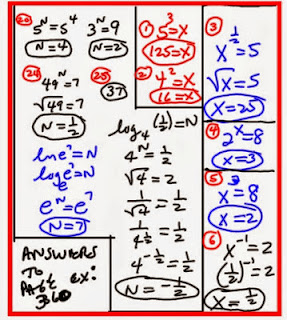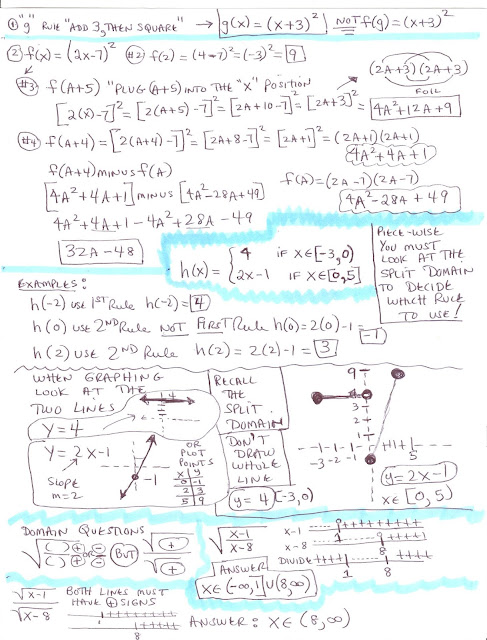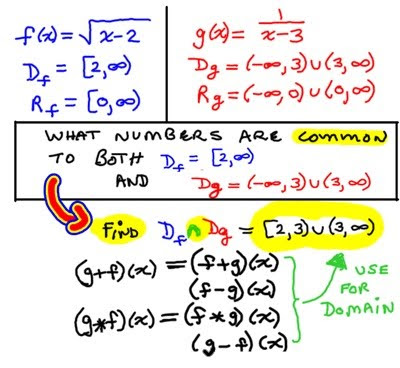YOU MUST KNOW THIS STUFF:
I am in my Math Dept. Office from 12:00 until class on Mon., Wed., and Friday.
Please stop in for help! - I am more than glad to:
- Re-teach a topic OR - Help on a homework problem
- Help with a Math technique that I may have assumed that you knew before entering the class
- We can do more example problems from a topic that seems to be troubling you
****************3rd EXAM - TEST on FRIDAY, NOV. 8th******************
Possible Questions:
Find the RADIAN measure of the angle with the given degree measure.
36 degrees
72 degrees
900 degrees
1200 degrees
-120 degrees
-225 degrees
Find the DEGREE measure of the angle with the given radian measure.
4pi/5
3pi/4
13pi/6
13pi/12
The measure of an angle in standard position is given in DEGREES.
Find the coterminal angle with the given condition.
GIVEN: (-120 degrees) -> Find a coterminal partner between zero and 360 degrees. ____________
GIVEN: (-150 degrees) -> Find a coterminal partner between zero and 360 degrees. ____________
GIVEN: (780 degrees) -> Find a coterminal partner between zero and 360 degrees. ____________
GIVEN: (650 degrees) -> Find a coterminal partner between zero and 360 degrees. ____________
Find an angle between 0 and 2pi RADIANS that is coterminal with:
7pi/3
15pi/4
-13pi/4
-9pi/4
Find the length of an arc that subtends a central angle of 30 degrees
in a circle of radius 8 meters.
Find the length of an arc that subtends a central angle of 3pi/2 radians
in a circle of radius 8 meters.
Find the area of a sector that is formed in a circle of diameter 14 meters.
This sector subtends a central angle of 120 degrees.
Find the area of a sector that is formed in a circle of diameter 14 meters.
This sector subtends a central angle of pi/4 radians.
**********PLUS some from the last double quiz*******************
1) If $7896 is invested at 6%. The interest is compounded monthly.How much money will be available after 7 years?
2) What is the PRESENT VALUE of $8976 under the conditions that
the money would be invested at 8% for 11 years and compounded daily?
(In other words: What would I need to invest at 8% now to have $8976 in 11 years?)
3) Starting with 2500 units of substance, find the amount remaining after
8 years with continuous compounding under a decomposition of 4%
4) Find the Annual Percentage Yield for 8% compounded continuously.
5) Switch each Logarithmic Form to the corresponding Exponential Form.
6) Switch each Exponential Form. to the corresponding Logarithmic Form.
7) Find the value of "z" in each equation
***********Find the Final Amount or Find the Initial Amount
another name for this finding the PRESENT VALUE***************
1) $7000 - at 4% - compounded yearly - for years - results in $8516.570317
2) $7000 - at 4% - compounded monthly - for 5 years - results in $8546.976158
3) $7000 - at 4% - compounded daily - for 5 years - results in $8549.72561
4) $3658 - @ 5% - compounded daily - for 7 years - becomes $5190.824665
5) $3658 - @ 5% - compounded monthly - for 7 years - becomes $5187.175879
6) $3658 - @ 5% - compounded yearly - for 7 years - becomes $5147.17334
7) $8,187.39725 - at 4% - compounded daily - for 5 years - results in $10,000
8) $4,493.4866 - at 4% - compounded daily - for 20 years - results in $10,000
*** With Continuous Compounding any of the four variables can be found given the other 3
**(e = 2.71828182...)*****
9) $3658 - @ 5% - compounded continuously - for 7 years - becomes $5190.949093
10) 9876 - Decaying continuously - @ 6% - for 10 years - becomes 5420.063718
11) $7000 - at 4% - compounded Continuously - for 5 years - results in $8549.819307
12) $8187.307531 - at 4% - compounded Continuously - for 5 years - results in $10,000
13) $4493.289641 - at 4% - compounded Continuously - for 20 years - results in $10,000































































